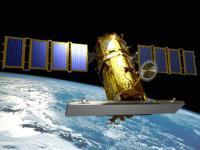KOMPSAT-5 is an earth observation satellite equipped with Korea's first all-weather SAR.
The SAR mounted on KOMPSAT-5 emits microwaves to an object on the ground and synthesizes the reflected signal to produce an image. It enables ground observation even during nighttime and poor weather conditions.
As the SAR image can supplement the optical camera, which can record only the visible light spectrum, it is utilized in mutual supplementary operations with the high-resolution optical images of KOMPSAT-3 and KOMPSAT-3A.
KOMPSAT-5 observes the Korean Peninsula four times a day. The transmitted image data are used for public safety, natural disaster forecasts, land/resource management and environmental monitoring.
The primary mission of the KOMPSAT-5 system is to provide high resolution mode SAR images of 1 meter resolution, standard mode SAR images of 3 meter resolution and wide swath mode SAR images of 20 meter resolution with viewing conditions of the incidence angle of 45 degrees using the COSI (COrea SAR Instrument) payload, for meeting GOLDEN mission objectives.
The secondary mission of KOMPSAT-5 is to generate the atmospheric sounding profile and support radio occultation science using AOPOD (atmospheric occultation and precision orbit determination) secondary payload which is composed of a dual frequency GPS receiver and a laser retroreflector array (LRRA).
Instruments:
COSI (Corea SAR Instrument)
AOPOD (Atmosphere Occultation and Precision Orbit Determination)
LRRA (Laser Retro Reflector Array)
